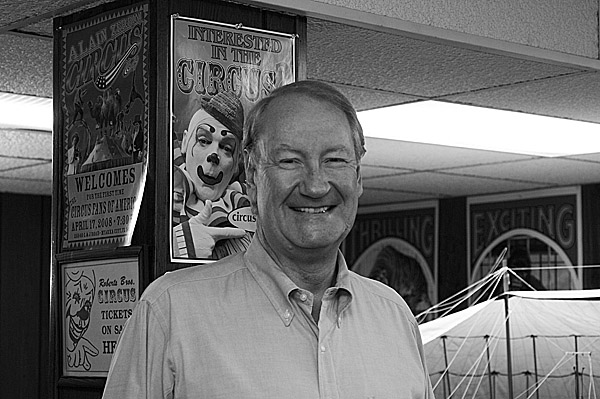Circus!
Life Under the Big Top
By Mort Gamble

Mort Gamble, a lifelong circus enthusiast, at home in Charleston. Photograph
by Michael Keller.
Once upon a time, the mere mention of the word "circus" inspired thrills and excitement beyond measure. On barns and fences, in store windows, and wrapped around telephone poles, posters portrayed attractions that you just had to see. Circus Day was coming at you! A holiday on wheels. Trucks, railroad cars, wagons loaded with the strange, the odd, the curious, the beautiful, the sensational, the unforgettable — a caravan with exotic people and animals that invaded a town for one day only, hijacked your sense of the normal, the routine, then evaporated like a dream.
One a warm May afternoon in the late 1950's, my mother, little brother, Dave, and I waited expectantly on blue wooden bleachers in our hometown of Moorefield for the matinee performance of the Beers & Barnes Circus to begin. For weeks, we had stared at the poster on a nearby shed — a grinning clown pointing a gloved finger at the happy date of arrival. Finally, the circus had rolled into Moorefield, materializing on a nondescript most important real estate in the world, the show beckoned with mysterious tents and colorful banners. The din of the generator truck mixed with the smells of spring grass under canvas, fresh popcorn, and dusty elephants. Within hours, it would all vanish again.
A candy vendor, or "butcher" in circus parlance, limped through the tent hawking Sno Cones, warming up the audience, and advising of a recent calamity.
"We had a little trouble a few days ago," he announced ominously, eyes flashing, with a hint of combat fatigue in his tone. "The big snake got loose."
Midway through a transaction with the butcher, my mother seemed skeptical of his yarn and even more wary of his stained hands. She selected the treats herself.
But I believed. To a seven year old growing up in rural West Virginia 50 years ago, a traveling big top circus was just about the most exhilarating enterprise you could see. Like many children, I was marked indelibly by the pure sensory joy of the circus. With Tinkertoys, a bandana, and household string, I soon created a model of a big top tent. My parents and grandparents dutifully took me to circus movies, like The Greatest Show on Earth and The Big Circus. Each time we visited a show, I would come home to my miniature version, sit for hours, and dream. I read book after book on the evolution of the American circus, from overland wagon troupes and gigantic productions transported by rail to the smaller truck shows that still played the "high grass" towns like Moorefield. I learned that the circus was a different world, with traditions, a social structure, and language all its own. I found myself stepping closer and closer to the center ring.
Meanwhile, I pursued a more academic interest in circuses. At Moorefield High and later after I transferred to Fairmont Senior High School, my teachers invited me to write essays and make presentations about my interest, which was becoming more and more my passion. By my sophomore year, I had fallen in love with everything circus. I poured through its history, learned its lingo, held it up to the light and discovered its metaphors. I joined the Circus Fans Association of America, the Circus Historical Society, and the Circus Model Builders. Most of all, I yearned to enter the big top's private domain, an ordered society that demanded long hours, unquestioning obedience, and fierce loyalty to the relentless routine of appearing in a different city or town each day.
I enrolled at WVU. During my senior year, I saw an ad for Circus Kirk, the "only all student, three ring, traveling tented circus on the road." High school and college students operated the show, which was held together by the iron voice and indomitable will of its owner and founder, Dr. Charles W. "Doc" Boas, a former professional clown, booking agent, and advance man who now also happened to be a college professor.
I joined the circus as a food concessionaire — a butcher. And so, on West Virginia University's graduation day in 1973, I was not sitting in academic regalia in the Coliseum. I was in mud, far from my home, fiddling with an uncooperative cotton candy machine. Like many troupers, I was assigned multiple jobs. In addition to being the head butcher, I was also the main entrance tent (marquee) superintendent, the ice man, and the trash collector. Around the show, I was known simply as the "popcorn king."
The circus veterans quickly wised me up.
You can read the rest of this article in this issue of Goldenseal, available in bookstores, libraries or direct from Goldenseal.